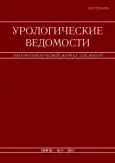Diagnosis of bladder outletobstruction based on results of standard urological examination patients with benign prostatichyperplasia
- Authors: Amdiy R.E.1, Giorgobiani T.G.1
-
Affiliations:
- St.-Petersburg State I. P. Pavlov Medical University
- Issue: Vol 2, No 3 (2012)
- Pages: 8-13
- Section: Articles
- Submitted: 30.03.2016
- Published: 15.09.2012
- URL: https://journals.eco-vector.com/uroved/article/view/2492
- DOI: https://doi.org/10.17816/uroved238-13
- ID: 2492
Cite item
Abstract
Diagnosis of bladder outletobstruction based on results of standard urological examination patients with benign prostatichyperplasia
Full Text
About the authors
Refat Eldarovich Amdiy
St.-Petersburg State I. P. Pavlov Medical University
Email: R.E.Amdiy@mail.ru
doctor of medical science, associate professor, department of Urology
Timur Georgievich Giorgobiani
St.-Petersburg State I. P. Pavlov Medical University
References
- Abrams P., Cardozo L., Fall M. et al. The standardisation of terminology in lower urinary tract function: report from the Standardisation Sub-committee of the International Continence Society // Neurourol. Urodynam. 2002. Vol. 21, N 2. P. 167–178.
- Griffiths D. J., Constantinou C. E., Mastrigt van R. Urinary bladder function and its control in healthy females // American Journal of Physiology. 1986. Vol. 251. P. 225–230.
- Hakenberg O. W., Pinnock C. B., Marshall V. R. Preoperative urodynamic and symptom evaluation of patients undergoing transurethral prostatectomy: analysis of variables relevant for outcome // Br. J. Urol. Int. 2003. Vol. 91, N 4. Р. 375–379.
- Han D. H., Jeong Y. S., Choo M.S, Lee K. S. The efficacy of transurethral resection of the prostate in the patients with weak bladder contractility index // Urology. 2008. Vol. 71, N 4. P. 657–661.
- Homma Y. Pressure-flow studies in benign prostatic hyperplasia: to do or not to do for the patient? // Br. J. Urol. Int. 2001. Vol 87, N 2. Р. 19–23.
- Porru D., Jallous H., Cavalli V. et al. Prognostic value of a combination of IPSS, flow rate and residual urine volume compared to pressure-flow studies in the preoperative evaluation of symptomatic BPH // Eur. Urol. 2002. Vol 41, N 3. P. 246–249.
- Rodrigues P., Lucon A. M., Campos Freire G., Arap S. Urodynamic pressure flow studies can predict the clinical outcome after transurethral prostatic resection // J. Urol. 2001. Vol 165, N 2. P. 499–502.
- Shafer W. Basic principles and clinical application of advanced analysis of bladder voiding function // Urol. Clin. North Am. 1990. Vol. 17, N 2. P. 553–566.
- Schafer W., Abrams P., Liao L. et al. Good urodynamic practices: uroflowmetry, filling cystometry, and pressure-flow studies//Neurourol. Urodyn. 2002. Vol 21, N 1. P. 261–274.
- Steele G.S, Sullivan M. P., Sleep D. J., Yalla S. V. Combination of symptom score, flow rate and prostate volume for predicting bladder outflow obstruction in men with lower urinary tract symptoms // J Urol. 2000. Vol. 164, N 2. P. 344–348.
- Zhang P., Gao J., Wu Z. Urodynamic analysis of non-improvement after prostatectomy // Chin. Med. J. 2003. Vol. 115, N 7. P. 1093–1095.
Supplementary files








